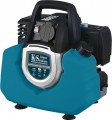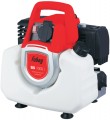Alternator winding
—
Copper. Copper winding is typical for advanced class generators. The copper alternator is characterized by high conductivity and low resistance. The conductivity of copper is 1.7 times higher than the conductivity of aluminium, such a winding heats up less, and compounds made of this metal endure temperature drops and vibration loads. Among the disadvantages of the copper winding, one can only note the high cost of the alternator. Otherwise, generators with copper winding have high reliability and durability.
— Aluminium. The aluminium winding of the alternator is typical for low-cost-class generators. The main advantages of aluminium are light weight and low price; otherwise, such a winding is usually inferior to copper counterparts. An oxide film is created on the surface of aluminium, it appears everywhere, even in the places of contact soldering. The oxide film undermines the contacts and does not allow the outer protective braid to securely hold the aluminium conductors.
Motor type
Model name of the engine installed in the generator. Knowing this name, you can, if necessary, find detailed data on the engine and clarify how it meets your requirements. In addition, model data may be needed for some specific tasks, including maintenance and repair.
Note that modern generators are often equipped with
branded engines from famous manufacturers: Honda, John Deere, Mitsubishi, Volvo, etc. Such engines are more expensive than similar units from little-known brands, but this is offset by higher quality and/or solid warranty conditions , and in many cases, the ease of finding spare parts and additional documentation (such as manuals for special maintenance and minor repairs).
Power
The operating power of the engine installed in the generator. Traditionally stated in horsepower; 1 HP approximately equal to 735 watts.
First of all, the rated power of the generator directly depends on this indicator (see above): in principle, it cannot be higher than the engine power, moreover, part of the engine power is spent on heat, friction and other losses. And the smaller the difference between these capacities, the higher the efficiency of the generator and the more economical it is. However high efficiency affects the cost, but this difference can pay off with regular use due to fuel savings.
Fuel consumption
Fuel consumption of a gasoline or diesel generator, and for combined models — when using gasoline (see "Fuel").
A more powerful engine inevitably means more fuel consumption; however, models with the same engine power may differ in this indicator. In such cases, it is worth considering that a model with a lower flow rate usually costs more, but this difference can quickly pay off, especially with regular use. In addition, knowing the fuel consumption and tank volume, you can determine how long one refueling will last; at the same time, in inverter models at partial load, the actual operating time may be noticeably higher than the theoretical one, see "Alternator" for details.
Continuous operation time
The time during which the generator is guaranteed to operate without interruption.
This parameter is indicated exclusively for liquid fuel models with a built-in tank, and according to the simplest formula: tank capacity divided by fuel consumption. However, in some models, data may be provided for a certain load level (which is specified in the notes); at a higher or lower load, the operating time will be shorter or longer, respectively. As for specific numbers, in most modern generators the operating time is
up to 8 hours - this is quite enough for backup power and occasional use. More reputable models are capable of working for
8 – 12 hours, and an indicator of
13 hours and above is typical mainly for professional solutions.
We also note that, theoretically, many generators can be refueled without shutting down, but in practice it is better to take breaks and not exceed the stated time of continuous operation - this will avoid overheating and increased wear.
Sockets 230 V
The number of 230 V sockets provided in the design of the generator, as well as the type of connectors used in such sockets.
The type of connector in this case is indicated by the maximum current that is allowed for the outlet — for example, "2 pcs at 16 A". The most popular options for 220-volt outlets are
16 A,
32 A and 63 A. We emphasize that the amperes in this designation are not the actual current that the generator can produce, but the outlet's own limitation; the actual value of the current strength is usually noticeably lower. Simply put, if, for example, the generator has a 32 A socket, the output current on it will not reach 32 A; and the specific number of amperes will depend on the rated and maximum power of the unit (see above). So, if for our example we take a rated power of 5 kW and a maximum of 6 kW, then such a generator can deliver less than 5 kW / 230 V = 22.7 A nominally and 6 kW / 230 V = 27 to a 230 V socket, 3 And at the peak. And if the power has to be divided between several outlets, then it, accordingly, will be even less.
As for specific types of connectors, the higher the current allowed for the outlet, the higher the requirements for its reliability and quality of protection. Thus, usually, smaller power plugs can be connected to higher power sockets (directly or through an adapter), but not vice versa. And if there are several sockets, by their type it is pos
...sible to estimate with a certain certainty the distribution of the entire power of the generator between them: between two identical sockets, this power is usually divided equally, and more power is allocated to the socket for a larger number of amperes. However, specific details on this matter should be clarified in each case separately; also consider 400 V sockets, if available (see below).Sound insulation cover
Special
protective covercovering the generator from the outside. As the name implies, the main purpose of this shell is to reduce the noise level, but its role is not limited to this. Among other things, the casing additionally protects the generator itself from water, dust, shock and other adverse effects; and in the event of a serious breakdown, it can delay the flying fragments of the unit, protecting the people around. Thus, this feature has a positive effect on overall reliability and safety; on the other hand, the presence of an additional shell affects the cost and weight.

